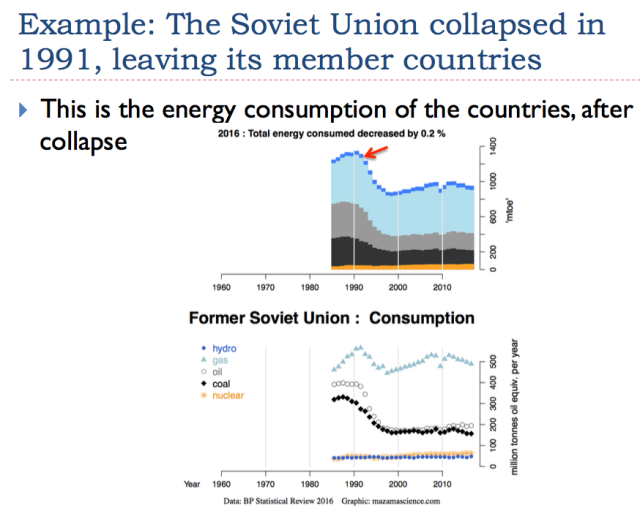Recently, a Spanish group called “Ecologist in Action” asked me to give them a presentation on what kind of financial crisis we should expect. They wanted to know when it would be and how it would take place.
The answer I had for the group is that we should expect financial collapse quite soon–perhaps as soon as the next few months. Our problem is energy related, but not in the way that most Peak Oil groups describe the problem. It is much more related to the election of President Trump and to the Brexit vote.
I have talked about this subject in various forms before, but not since 2016 energy production and consumption data became available. Most of the slides in this presentation use new BP data, through 2016. A copy of the presentation can be found at this link: The Next Financial Crisis.1
Most people don’t understand how interconnected the world economy is. All they understand is the simple connections that economists make in their models.

Energy is essential to the economy, because energy is what makes objects move, and what provides heat for cooking food and for industrial processes. Energy comes in many forms, including sunlight, human energy, animal energy, and fossil fuels. In today’s world, energy in the form of electricity or petroleum makes possible the many things we think of as technology.
In Slide 2, I illustrate the economy as hollow because we keep adding new layers of the economy on top of the old layers. As new layers (including new products, laws, and consumers) are added, old ones are removed. This is why we can’t necessarily use a prior energy approach. For example, if cars can no longer be used, it would be difficult to transition back to horses. This happens partly because there are few horses today. Also, we do not have the facilities in cities to “park” the horses and to handle the manure, if everyone were to commute using horses.

In the past, many local civilizations have grown for a while, and then collapsed. In general, after a group finds a way to produce more food (for example, cuts down trees so that citizens have more area to farm) or finds another way to otherwise increase productivity (such as adding irrigation), growth at first continues for a number of generations–until the population reaches the new carrying capacity of the land. Often resources start to degrade as well–for example, soil erosion may become a problem.
At this point, growth flattens out, and wage disparity and growing debt become greater problems. Eventually, unless the group can find a way of increasing the amount of food and other needed goods produced each year (such as finding a way to get food and other materials from territories in other parts of the world, or conquering another local civilization and taking their land), the civilization is headed for collapse. We recently have tried globalization, with exports from China, India, and other Asian nations fueling world economic growth.
At some point, the efforts to keep growing the economy to match rising population become unsuccessful, and collapse sets in. One of the reasons for collapse is that the government cannot collect enough taxes. This happens because with growing wage disparity, many of the workers cannot afford to pay much in taxes. Another problem is greater susceptibility to epidemics, because after-tax income of many workers is not sufficient to afford an adequate diet.

A recent partial collapse of a local civilization was the collapse of the Soviet Union in 1991. When this happened, the government of the Soviet Union disappeared, but the governments of the individual states within the Soviet Union remained. The reason I call this a partial collapse is because the rest of the world was still functioning, so nearly all of the population remained, and the cutback in fuel consumption was just partial. Eventually, the individual member countries were able to function on their own.
Notice that after the Soviet Union collapsed, the consumption of coal, oil and gas collapsed at the same time, over a period of years. Oil and coal use have not come back to anywhere near their earlier level. While the Soviet Union had been a major manufacturer and a leader in space technology, it lost those roles and never regained them. Many types of relatively high-paying jobs have been lost, leading to lower energy consumption.

As nearly as I can tell, one of the major contributing factors to the collapse of the Soviet Union was low oil prices. The Soviet Union was an oil exporter. As oil prices fell, the government could not collect sufficient taxes. This was a major contributing factor to the collapse. The collapse from low oil prices did not happen immediately–it took several years after the drop in oil prices. There was a 10-year gap between the highest oil price (1981) and collapse (1991), and a 5-year gap after oil prices dropped to the low 1986 price level.













Leave A Comment